Book review: Storm of Locusts
 Reviewed by Karl Hele
Reviewed by Karl Hele
Storm of Locusts is the second volume in Rebecca Roanhorse’s Sixth World series. The novel picks up Maggie Hoskie’s story about a month after the conclusion of events on Trail of Lightning. We follow Maggie and her friends in a quest to find a figure known as the White Locust and rescue her love interest Kai Arviso.
The rescue mission takes Maggie outside of Diné Lands into a world even more upside down. The friends encounter a group of ‘highwaymen’ who deal in flesh – the living and parts harvested from the unauctionable, as well as Dine Gods, along the way. Interestingly, while various Diné Gods play various roles in the novel, they are neither omnipresent or omniabsent.
Coyote, Ma’ii, makes a brief appearance, where we simply learn he is banished from Dinétah and living at a casino that remains open and under the control of the ‘gambling’ God, Nohoilpi. Nohoilpi directs Magi to Tó Neinili, the Rain God, who provides Maggie with some knowledge on how to use the lightning sword she took from a God in the first novel. While these are keys to the plot, the Gods do not drive the narratives and various subplots. Additionally, due to Maggie’s actions in the first novel, she is referred to as the Godslayer. She desperately does not want to be known as a Godslayer, but in the final moments of novel’s climatic confrontation in Storm of Locusts, she becomes a Godslayer.
From the outset, Roanhorse has Maggie trying to resist her killer instincts. Instead of killing her opponents, Maggie now seeks to render unconscious, injure, or disable those she encounters; that is until she encounters the White Locust. This ‘turning over a new leaf’ and immediate transformation back into a killer is a disappointing aspect of the novel and at times hard to digest, particularly the rapidity in which Maggie transforms back into the killer.
Further clan powers of various Diné characters continue to appear. For instance, Ben, a young woman Maggie is responsible for, has the powers of tracking and the nimbleness of deer or mountain goats, while the White Locust can enchant with song, control metal, and summon swarms of all devouring locusts.
Unfortunately, the Storm of Locusts’ ending too blatantly establishes the overarching plot of the next novel. Nonetheless, Storm of Locusts is an action packed fast-paced easy read that generally does not disappoint. Yet the questions about utilizing Diné traditions and stories to create a post-apocalyptic novel remain, Roanhorse’s acknowledgements do seem to reference it via thanking her Diné friends, family, and readers for encouraging her to continue. Regardless, I am looking forward to the third novel in the series!
Rebecca Roanhorse, Storm of Locusts, Toronto: Saga Press, 2019.


